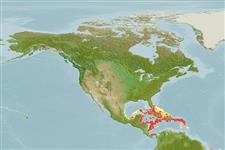Holocephali (Chimären, Seekatzen) (chimaeras) >
Chimaeriformes (Chimaeras) >
Chimaeridae (Shortnose chimaeras or ratfishes)
Etymology: Chimaera: Named for the mythological creature composed of parts of multiple animals, referring to their odd mix of characteristics. (See ETYFish); cubana: -ana (L.), belonging to: Cuba, referring to Matanzas Bay, Cuba, type locality. (See ETYFish).
Environment: milieu / climate zone / depth range / distribution range
Ökologie
seewasser bathydemersal; tiefenbereich 180 - 900 m (Ref. 51158). Deep-water
Western Central Atlantic: off Matanzas Bay, Cuba (Ref. 26938) and Jamaica.
Size / Gewicht / Alter
Maturity: Lm ? range ? - ? cm
Max length : 75.0 cm TL Männchen/unbestimmt; (Ref. 26938)
Rückenflossenstacheln (insgesamt) : 1. Rounded snout; head with seam-like sensory grooves on head; pectoral fins large; first dorsal fin with a long, sharp spine; a separate anal fin, not extending past the level of end of second dorsal fin. Curved club-shaped appendage between eyes in males. Lateral line canals in open grooves (Ref. 26938). Upper surface silvery gray, lower surface white (Ref. 6902).
Solitary (Ref. 26340). Oviparous (Ref. 205). Eggs are encased in horny shells (Ref. 205). Unlikely to be seen by divers since this ratfish lives in very deep water (Ref. 26938).
Life cycle and mating behavior
Maturities | Fortpflanzung | Spawnings | Egg(s) | Fecundities | Larven
Claro, R., 1994. Características generales de la ictiofauna. p. 55-70. In R. Claro (ed.) Ecología de los peces marinos de Cuba. Instituto de Oceanología Academia de Ciencias de Cuba and Centro de Investigaciones de Quintana Roo. (Ref. 26340)
IUCN Rote Liste Status (Ref. 130435)
Bedrohung für Menschen
Harmless
Nutzung durch Menschen
Fischereien: nicht kommerziell
Tools
Zusatzinformationen
Download XML
Internet Quellen
Estimates based on models
Preferred temperature (Ref.
123201): 9 - 18.2, mean 13.4 °C (based on 48 cells).
Phylogenetic diversity index (Ref.
82804): PD
50 = 0.5000 [Uniqueness, from 0.5 = low to 2.0 = high].
Bayesian length-weight: a=0.00282 (0.00118 - 0.00673), b=3.10 (2.89 - 3.31), in cm total length, based on LWR estimates for this (Sub)family-body shape (Ref.
93245).
Trophic level (Ref.
69278): 3.6 ±0.5 se; based on size and trophs of closest relatives
Widerstandsfähigkeit (Ref.
120179): niedrig, Verdopplung der Population dauert 4,5 - 14 Jahre. (Assuming fecundity<100).
Fishing Vulnerability (Ref.
59153): Moderate to high vulnerability (50 of 100).
